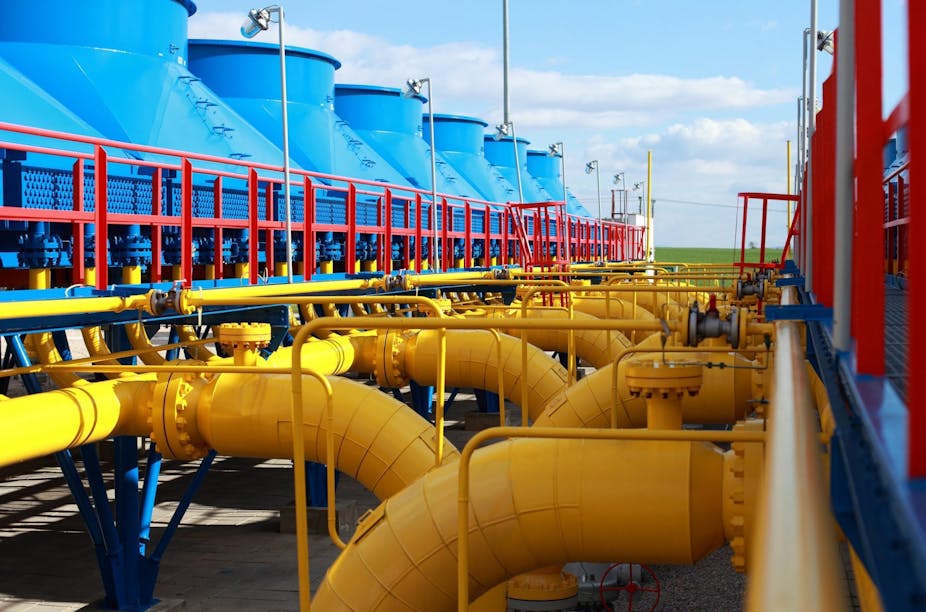The ongoing standoff between Russia and Ukraine has exacerbated Europe’s vulnerability caused by its reliance on Russian gas.
The situation has locked the two nations into a dispute over paying for gas exports, similar to the price disputes that saw supplies cut off in 2006 and 2009. Those earlier disputes, between the Russian government-controlled producer Gazprom and its two major transit countries, Ukraine and Belarus, had knock-on effects for several European countries.
Europe gets about a quarter of its natural gas from Russia, half of which passes through Ukraine. As a result, some European countries remain highly vulnerable to Russia’s ability to use gas pricing as a political lever.
Of the 28 European Union (EU) member states, 13 rely on Russia for at least half of their gas, while a further six states use Russian gas for at least 20% of their supplies. Most exposed are central and eastern Europe and the Baltic, where some countries rely exclusively on Russian gas (as detailed on page 28 of BP’s world energy report).
Europe needs more places to buy natural gas. The question is whether Australia can be one of them.
Europe’s import options
Europe has the capacity to import a lot more liquefied natural gas (LNG). Its LNG imports dropped from a peak of 86.5 billion cubic metres (bcm) in 2011 to only 45.7 bcm in 2013, because of increased competition from Asia and particularly a surge in Japan’s imports after the Fukushima disaster. Japan now imports three times as much LNG as the entire EU.
Despite wanting to reduce its reliance on Russia, European gas imports are nevertheless on trend to increase by 27% by 2020. Where is this gas going to come from?
One option is the burgeoning US shale gas market. During a recent visit to Europe, US President Barack Obama said that “the crisis in Ukraine underscores the need for the European Union to consider imports of natural gas from the US”.
However, there are practical difficulties. First, no export facilities are yet up and running, and most US shale gas projects are set to come online towards the end of the decade. Second, while US LNG exports are forecast to hit 66bcm by the early 2020s, a significant share of it is likely to go to more lucrative Asian markets. Finally, there is a domestic lobby in the United States that believes that restricting exports will keep domestic gas prices low.
Besides Russia, the EU’s other major gas suppliers are Norway, Algeria and Qatar. Norway and Algeria, which already export most of their gas to the EU, would not be able to increase production by any more than 10%. Qatar, on the other hand, is selling its gas at higher prices to Asia.
The Australian angle
So given Europe’s limited options for increasing gas imports from the United States and its traditional suppliers, is there a gap in the market for Australia to exploit?
Australia currently exports all of its LNG to Asia. But with almost 100bcm of new capacity set to come on stream, Australia is on track to become the largest global LNG exporter by 2017 and the largest overall LNG producer by 2020, in both instances overtaking Qatar.
But Australia’s new gas projects are almost exclusively financed by Asian importers under long-term supply contracts. As long as LNG prices in Asia remain above those in Europe, exporters will continue to favour Asian markets.
Asian LNG importers have tried to start driving down the prices they pay, by buying cheaper American gas and setting up a gas trading hub in Singapore. But these efforts are unlikely to achieve a global LNG price in the short term, so if Europe wants to diversify its gas imports it will need to match the prices paid by Asian importers – not likely given the state of the EU economy.
Pipelines and tankers
Prices aside, infrastructure is another issue to consider. Spain does not rely on any Russian gas, mainly because it has lots of coast to receive LNG transport ships. Spain has five LNG-receiving ports, while the rest of the EU combined has only seven, mainly in the west, although more are planned.
Eastern and central Europe, the regions that are most dependent on Russian gas, have no LNG terminals. Some countries, such as Austria, the Czech Republic, Slovakia and Hungary, are landlocked. The priority here would be to fast-track the construction of LNG terminals in neighbouring coastal countries such as Poland and Croatia.
LNG terminals are hugely expensive, and need to have long-term supply contracts in place with exporters. This kind of project would require a gargantuan joint commitment by several central and eastern European countries – most of which remain in or near recession.
For all these reasons, the idea of exporting LNG from Australia to Europe is a long shot, despite the apparent opportunity created by the instability in Ukraine and the appetite for diversity among Europe’s gas buyers.
Winston Churchill was right when he said, in the runup World War I, that “safety and certainty in oil lie in variety and variety alone”. The same is true of LNG today, but just because something is a good idea it doesn’t mean it will definitely happen.
If current market conditions prevail, Europe is unlikely to wean itself off Russian gas, while Australia’s LNG will remain destined for Asia.

